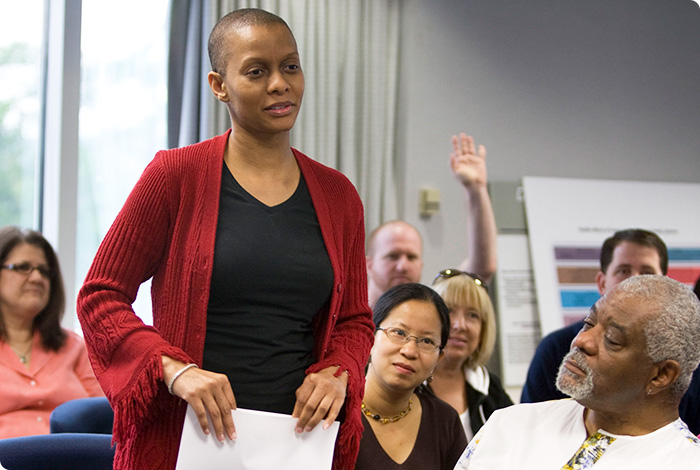Gathering Information

It is important to remember that “engagement” is a two-way dialogue. Community engagement activities that are not informed by ongoing dialogue with the community, stakeholders, and state, territorial, local, and tribal (STLT) partners can lead to distrust and feelings of injustice, particularly when activities are perceived as insensitive to community concerns and needs. Take a proactive approach to engage community members in collaborating and participating and employ effective listening skills. A proactive approach can help you understand how community members are thinking about and understanding the contamination. Remember that every interaction can improve or affect the relationships your team builds with the community.
There are many different formats for gathering information. When selecting your format, consider the goals and intended outcomes of the interaction.

Here are some common ways to gather information:
- Informal conversations, phone calls, and email communication
- Public meetings, availability and poster sessions, and other planning meetings
- Stakeholder interviews, also known as key informant interviews
- Focus groups
- Surveys and polls
- Booths at local events
- Public comment periods on official reports
It’s important to stay flexible! The information you gather from community members should inform community engagement planning and any activities or changes made moving forward. Implementing community feedback in your public health work and community engagement activities is the best way to demonstrate that you are truly listening.
- Define your audience and determine the appropriate format for the type of information you want to gather.
- Identify exactly what you need from the interaction and develop supporting materials (e.g., an interview guide).
- Think through all logistics. Consider different ways to connect with the community, like small groups, public availability/poster sessions, one-on-one phone calls, etc. Ask yourself “What could go wrong?” for the specific format you choose and plan around it. For example, if you are doing a live stakeholder interview, make sure someone else is there to take notes. Having a note taker will allow you to focus on the conversation.
- Remember to ask, “Are there any other opinions on this?” and “Is there anyone else I should talk with?”
Develop strategies for ongoing dialogue with community members. Listen empathically and validate individuals’ concerns. Create a safe space where people feel they can be open and honest. Remember that listening is a great opportunity to build trust and that community members are better placed to know whether a certain approach, activity and/or message will be well received and embraced.
Recognize that when you ask for community members’ opinions, they may share needs beyond ATSDR’s scope of work. Be prepared to validate their needs and offer helpful resources. Maintain a network of federal, state, and local agencies, so that you can connect communities with other agencies with helpful resources outside of ATSDR’s scope.
Guard privacy and be aware of information shared with you in confidence. Do not downplay the community’s concerns, imply that the community is exaggerating, or imply that the community lacks perspective. Doing any of those things will lead you to lose trust and credibility. Instead, acknowledge their concerns and express empathy with the information they have shared, even if it is not directly related to the exposure.
When you gather information during community engagement, keep in mind the legal restriction on systematic information collection from the public by federal employees. In 1995 Congress passed the Paperwork Reduction Act with the goals of (1) reducing the burden of data collection on the public; (2) improving data quality; and (3) strengthening privacy protections. When conducting focus groups, surveys, etc., the law requires any data collection process or instrument that will be administered, whether mandatory or voluntary, to 10 or more non-federal individuals or entities within a 12-month period to be reviewed and approved by the President’s Office of Management and Budget (OMB). For more information visit https://pra.digital.gov/.
*NOTE FOR ATSDR STAFF: CDC/ATSDR uses the Study Tracking and Reporting System (STARS) for the submission, review, clearance, tracking, and reporting of research and non-research for the following activities: human subjects research (HSR) determinations; Office of Management and Budget (OMB) Paperwork Reduction Act (PRA) determinations; data management plan (DMP) reviews; and contract, grant and cooperative agreement reviews (sometimes referred to as “funding determinations”) for HSR and PRA requirements.
Active listening is more than just paying attention [Robertson 2005]. Active listening is not about solving the speaker’s problems. The main objective of active listening is making the speaker feel heard and understood. It requires that you give the speaker your undivided attention, listen without interrupting, and seek to understand without judging.
This technique is grounded in a tremendous body of scientific literature. According to research, active listening is particularly effective with individuals who have suffered various types and degrees of trauma. When done authentically, active listening is a simple but powerful tool for establishing rapport and building trust. (See resource: ATSDR A Guide for Active Listening)
- ATSDR A Guide for Active Listening (ATSDR). A guide for using active listening when gathering information from community members.
- ATSDR Communication Toolkit: Community Concern Assessment Tool (ATSDR). A guide and template for assessing the level and nature of community concern as a result of environmental contamination.
- ATSDR Communication Toolkit: Event Evaluation Form (ATSDR). A template for gathering feedback from attendees after an event.
- ATSDR Communication Toolkit: Media Analysis Guide (ATSDR). Tips and pointers on how to do a quick media analysis to help you gather data about the site and determine the level of concern in the community.
- ATSDR Communication Toolkit: Stakeholder Interview Guides (ATSDR):
- General Topic Guide for Community-Based Organization Interviews: A guide for interviewing representatives of community-based organizations.
- General Topic Guide for Community Member Interviews: A guide for interviewing community members.
- General Topic Guide for Industry Interviews: A guide for interviewing industry professionals in a community.
- General Topic Guide for Policymaker Interviews: A guide for interviewing policy makers.
- ATSDR Community Stress Resource Center (ATSDR). A toolkit containing guidance, tools, and a practical framework for reducing community stress and building resilience as part of a public health response to environmental contamination.